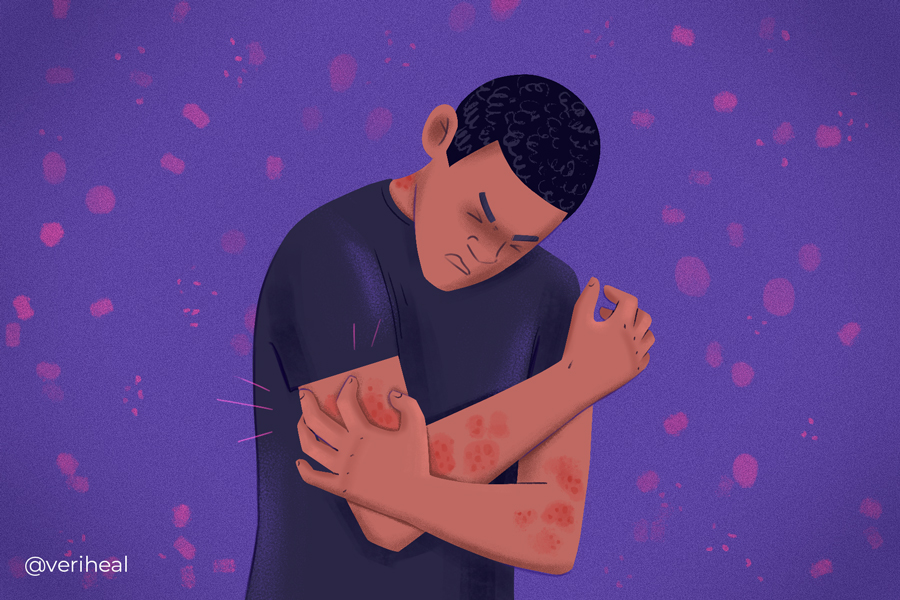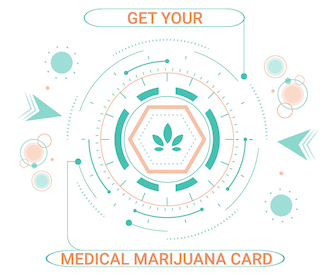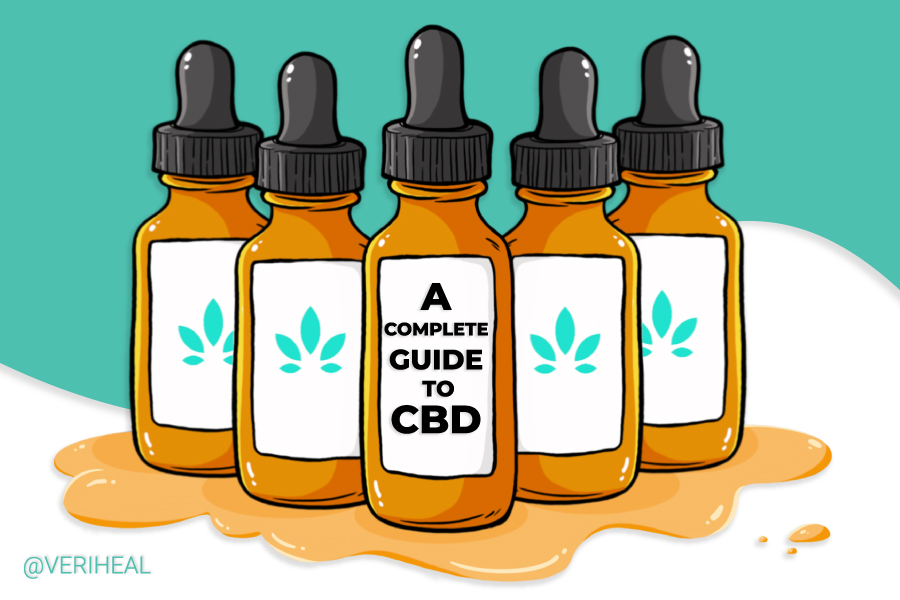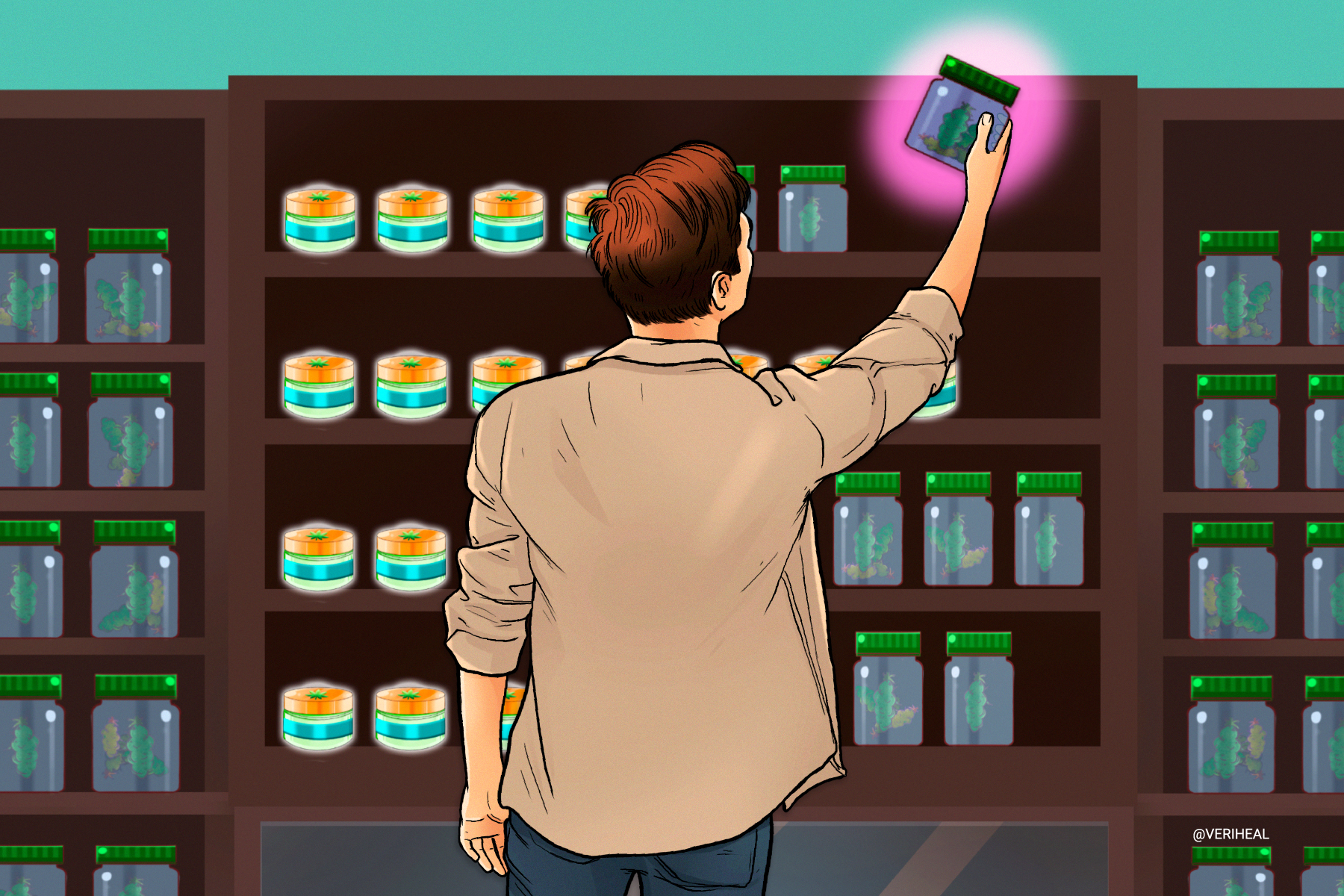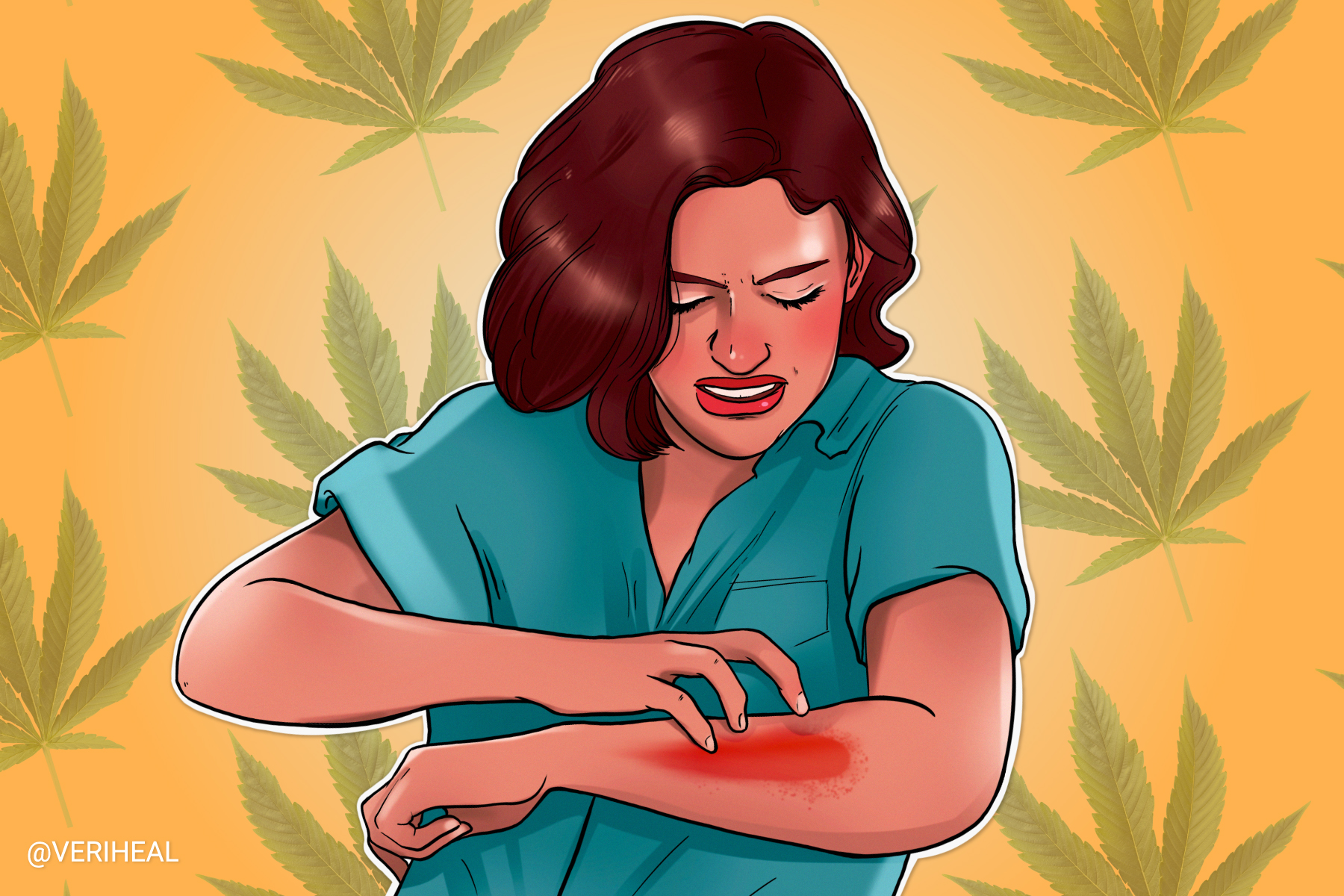Learn How Medical Marijuana Helps with Psoriasis Symptoms
- CBD for Psoriasis
- What is Psoriatic Arthritis
- Different Treatment Recommendations for Psoriasis
- Understanding the Different Types and Symptoms of Psoriasis
- What Does the Science Say About Psoriasis and CBD?
The ability for cannabis to relieve psoriasis begins when it contacts CB1 and CB2 receptors that are a part of the endocannabinoid system (ECS). The ECS is made up of fat-based neurotransmitters that are made in the body called endocannabinoids and cannabinoid receptors. After the CB1 and CB2 receptors are activated, levels of endocannabinoids such as anandamide are either raised or lowered, creating a chain of neurotransmitter levels that result in bodily process changes in the central nervous system and peripheral organs.
Cannabis contains hundreds of cannabinoids and chemical compounds that work to activate the ECS. The most well-known cannabinoids are Δ9-tetrahydrocannabinol (THC), known for its psychogenic effects, and cannabidiol (CBD), known for its pain reducing and muscle soothing capabilities.
Research over the last two decades shows that the skin contains CB1 and CB2 receptors (19). This confirms that cutaneous cannabinoid signaling is heavily involved in the functions of the skin and skin cells, including skin barrier formation and regeneration as well as skin homeostasis.
When the cannabinoid signaling is not regulated properly in the skin, conditions such as psoriasis, dermatitis, keratin disorders, and acne can result (19). Research has shown that phytocannabinoids such as cannabichromene (CBC), cannabigerol (CBG), THC, and CBD are potential topical anti-inflammatory agents for the skin (18). This is supplemented by the findings that phytocannabinoids inhibit proliferation of keratinocytes, the primary type of cell found on the skin (16). This causes less skin cell buildup and prevents flare-ups, features of psoriatic plaques.
For more information on how the endocannabinoid system works, please see our page on endocannabinoids here.
CBD for Psoriasis
CBD has been shown to have greater therapeutic potential for relieving skin inflammation, such as that found in psoriasis (18). The goal is to reduce pain and itching (2). In addition, it can help (10):
- Remove debris
- Promote wound healing
- Improve skin hydration and elasticity
- Improve quality of life measures on the psoriatic index
What is Psoriatic Arthritis?
Psoriatic arthritis (PsA) affects up to 30% of patients who have a psoriasis diagnosis. It is considered a chronic, inflammatory disease where inflammation affects the joints and places where tendons and ligaments connect to the bone. It typically appears on patients between 30 and 50-years-old, but it can start at any age and affect children (13). Medical cannabis has been shown to help slow down the immune system, which helps control PsA.
Please check out our arthritis page for more information about treating PsA.
Different Treatment Recommendations for Psoriasis
Using medical cannabis for skin conditions and the treatment of psoriasis is an easy approach compared to treating other conditions. Most patients benefit from using marijuana topicals or creams. Many patients opt for using CBD oils and creams with other ingredients that may be beneficial for the skin such as camphor, which can relieve itching, or salicylic acid that helps break down thick and scaly skin (10).
While some patients may prefer to use CBD-only products because of a fear of feeling intoxicated, it is actually safe to utilize topical products that contain both THC and CBD. This is because when full-spectrum (full plant) medical cannabis is used topically, it absorbs into the skin where it is put on and it does not typically make its way into the patient’s bloodstream. In addition, full plant topicals utilize all the cannabinoids in cannabis, which helps reduce skin buildup in psoriatic plaques (16).
Another option that is available for patients with mild to moderate scalp psoriasis is to use a shampoo that contains CBD in order to reduce scalp inflammation within two weeks (20). This is also a great option for patients with seborrheic dermatitis as seen in a clinical trial. Keep in mind that large-scale research into topical treatments like CBD ointments, creams, and shampoos is needed to determine any benefits or long-term effects.
In 2019, a patent was filed for a cannabis-based product that is a topical psoriatic plaque treatment. This product contains both CBD and CBG. It may be able to restore the inflammatory balance of the skin, helping to eliminate psoriatic plaques (16).
It is very important to look at all the ingredients of CBD-only and full cannabis plant topicals, especially if your skin is sensitive to certain ingredients as they could cause more irritation on the skin (10). It is also necessary to make sure the CBD-only products you choose have a certificate of analysis and that you are receiving a quality and safe product to use. Check out our CBD guide for more information about how to find quality products.
Understanding the Different Types and Symptoms of Psoriasis
All forms of psoriasis are considered autoimmune diseases because the body’s immune system becomes overactive and attacks normal tissues, causing inflammation, tissue damage, and in some cases arthritis (12).
Psoriasis is typically a skin condition that causes red, itchy, and scaly skin patches that sometimes cause pain. How it is treated ranges depending on how severe the psoriasis is (12). The skin symptoms can go through flares for a few weeks or months and then subside into remission (11).
Let’s go over the locations and types of psoriasis. Locations of psoriasis include:
Scalp Psoriasis
Psoriasis of the scalp appears as thick, crusty, and white skin that covers the scalp. In addition, scalp psoriasis (15):
- Appears powdery with a silver sheen.
- Is often confused with seborrheic dermatitis, which is yellow, crusty, and oily.
- May be an indicator of PsA as many patients have the scalp form and arthritic form.
Genital Psoriasis
Genital psoriasis is location-based and is a fairly common form of psoriasis. This form of psoriasis affects the following (4):
- The creases between the thigh and genital area.
- Vulva, penis, or scrotum.
- The crease between the buttocks (including the skin around the anus).
- The pubis or skin above the genitals.
- Inner and upper thigh.
- Can be either plaque psoriasis or inverse psoriasis.
Facial Psoriasis
It is estimated that 50% of psoriasis patients have symptoms on their faces. It is specifically found on the following areas (15):
- Around the ear, behind the ear, and in the ear canal.
- It is rare, but it can be found in or around the mouth, including the gums, lips, tongue and cheeks.
- Psoriasis around the eyes is extremely rare but can cause discomfort and may impair vision.
Inverse Psoriasis (skinfold psoriasis)
Inverse psoriasis, also known as intertriginous psoriasis, appears as skin lesions that are purplish, brown, or darker than the surrounding skin (5). It is found near the (5):
- Armpits.
- Groin.
- Under the breasts.
- And other skin folds on the body.
Palmoplantar Psoriasis (PPP)
Palmoplantar psoriasis (PPP) is found on the hands, feet, fingernails, and toenails (17). The pain can limit mobility and keep patients from performing their usual daily tasks.
Different types of psoriasis include:
Plaque Psoriasis
Plaque psoriasis is the most common type, affecting 80-90% of patients who have been diagnosed with psoriasis (23). Additional details about plaque psoriasis include (23):
- It can occur anywhere on the body, but mostly on the scalp, knees, elbows, and torso.
- Plaques are typically symmetrical and appear on both sides of the body.
- Plaques appear as raised, inflamed, and scaly patches of skin.
- Appears purple, greyish, or darker brown on skin of color.
- Appears red on Caucasian skin.
Guttate Psoriasis
This type of psoriasis typically starts in childhood or young adulthood. It appears as (22):
- Small, round spots called papules are raised and sometimes scaly.
- Usually appears on the arms, legs, and torso, but can sometimes be found on the face, ears, and scalp.
- Typically triggered by an infection such as strep throat.
Pustular Psoriasis
General pustular psoriasis (GPP), or von Zumbusch psoriasis, can develop suddenly and progress quickly. It is often appears with a fever, chills, severe itching, fatigue, muscle weakness, and a change in heart rate (14). It is considered a medical emergency. In addition (14):
- It includes pustules or white, pus-filled, and painful bumps that may be surrounded by red skin.
- It is not contagious.
- Is called localized pustular psoriasis or palmoplantar pustular psoriasis when the symptoms affect the palms of the hands or the soles of the feet.
- Acropustulosis is when the symptoms only affect the tips of the fingers or toes.
Erythrodermic Psoriasis
Erythrodermic psoriasis only affects 2% of psoriasis patients and can be life-threatening. It often affects almost the entire body as it disrupts the body’s normal temperature and fluid balance (21). Additionally (21):
- It may lead to shivering episodes and swelling from fluid retention, called edema, in the feet or ankles.
- It may lead to a high risk of infection, pneumonia, and heart failure.
- See a doctor immediately if you experience:
- Severe redness or discoloration and shedding of skin over a large area of the body.
- Exfoliation of the skin occurs in large “sheets” instead of smaller scales.
- Increased heart rate
- Severe itching and pain.
- Body temperature going up and down, especially on very hot or cold days.
What Does the Science Say About Psoriasis and CBD?
A 2020 study from Skin Appendage Disorders examined 50 subjects with scalp psoriasis and seborrheic dermatitis who were using shampoo containing 0.075% broad-spectrum CBD for two weeks (20). These patients had mild to moderate scalp issues and were examined with trichoscopy head imaging for twisted capillary inflammation.
Overall, patients experienced a substantial decrease in the severity of inflammation as well as a larger reduction in itching and burning (20). There were no adverse reactions to the shampoo and symptom reduction satisfaction showed no differences between male and female test subjects.
Note: Veriheal does not intend to give this as professional medical advice. Do not attempt to self-diagnose or prescribe treatment based on the information provided on this page. Always consult a physician before making any decision on the treatment of a medical condition.
1. Ali, A., & Akhtar, N. (2015). The safety and efficacy of 3% Cannabis seeds extract cream for reduction of human cheek skin sebum and erythema content. Pakistan journal of pharmaceutical sciences, 28(4), 1389–1395. https://pubmed.ncbi.nlm.nih.gov/26142529/
2. Bíró, T., Tóth, B. I., Haskó, G., Paus, R., & Pacher, P. (2009). The endocannabinoid system of the skin in health and disease: novel perspectives and therapeutic opportunities. Trends in pharmacological sciences, 30(8), 411–420. https://www.ncbi.nlm.nih.gov/pmc/articles/PMC2757311/
3. Derakhshan, N., & Kazemi, M. (2016). Cannabis for Refractory Psoriasis-High Hopes for a Novel Treatment and a Literature Review. Current clinical pharmacology, 11(2), 146–147. https://pubmed.ncbi.nlm.nih.gov/27164964/
4. Genital psoriasis: Causes, triggers and treatments. (n.d.). Retrieved February 23, 2021, from https://www.psoriasis.org/genitals/
5. Inverse psoriasis. (n.d.). Retrieved February 23, 2021, from https://www.psoriasis.org/inverse-psoriasis/
6. Maida, V., Shi, R. B., Fazzari, F., & Zomparelli, L. (2020). Topical cannabis-based medicines – A novel paradigm and treatment for non-uremic calciphylaxis leg ulcers: An open label trial. International wound journal, 17(5), 1508–1516. https://www.ncbi.nlm.nih.gov/pmc/articles/PMC7540661/
7. Milando, R., & Friedman, A. (2019). Cannabinoids: Potential Role in Inflammatory and Neoplastic Skin Diseases. American journal of clinical dermatology, 20(2), 167–180. https://pubmed.ncbi.nlm.nih.gov/30542832/
8. Mounessa, J. S., BS, Siegel, J. A., BA, Dunnick, C. A., MD, & Dellavalle, R. P., MD, PhD, MSPH. (2017). The role of cannabinoids in dermatology [Abstract]. Journal of the American Academy of Dermatology, 77(1), 188-190. https://www.jaad.org/article/S0190-9622(17)30308-0/fulltext
9. Nishat. (2020, January 07). Cannabinoids in medicine part 3: Psoriasis and rheumatoid arthritis. Retrieved February 23, 2021, from https://www.openaccessgovernment.org/psoriasis-and-rheumatoid-arthritis/80187/
10. Onorati, H. (2021, May 18). Cbd for psoriasis and psoriatic arthritis. CBD for Psoriasis and Psoriatic Arthritis: National Psoriasis Foundation. https://www.psoriasis.org/advance/cbd-for-psoriasis-and-psa/
11. Psoriasis. (2021, February 05). Retrieved February 23, 2021, from https://www.niams.nih.gov/health-topics/psoriasis
12. Psoriasis. (2020, August 18). Retrieved February 23, 2021, from https://www.cdc.gov/psoriasis/index.htm
13. Psoriatic arthritis: Causes, symptoms and treatment. (n.d.). Retrieved February 23, 2021, from https://www.psoriasis.org/about-psoriatic-arthritis/
14. Pustular Psoriasis: Know the symptoms and signs. (n.d.). Retrieved February 23, 2021, from https://www.psoriasis.org/pustular/
15. Scalp Psoriasis: Causes, triggers and treatment options. (n.d.). Retrieved February 23, 2021, from https://www.psoriasis.org/scalp/
16. Scheau, C., Badarau, I. A., Mihai, L. G., Scheau, A. E., Costache, D. O., Constantin, C., Calina, D., Caruntu, C., Costache, R. S., & Caruntu, A. (2020). Cannabinoids in the Pathophysiology of Skin Inflammation. Molecules (Basel, Switzerland), 25(3), 652. https://www.ncbi.nlm.nih.gov/pmc/articles/PMC7037408/
17. Signs of nail psoriasis. (n.d.). Retrieved February 23, 2021, from https://www.psoriasis.org/hands-feet-nails/
18. Río, C. D., Millán, E., García, V., Appendino, G., DeMesa, J., & Muñoz, E. (2018). The endocannabinoid system of the skin. A potential approach for the treatment of skin disorders. Biochemical pharmacology, 157, 122–133. https://pubmed.ncbi.nlm.nih.gov/30138623/
19. Tóth, K. F., Ádám, D., Bíró, T., & Oláh, A. (2019). Cannabinoid Signaling in the Skin: Therapeutic Potential of the “C(ut)annabinoid” System. Molecules (Basel, Switzerland), 24(5), 918. https://www.ncbi.nlm.nih.gov/pmc/articles/PMC6429381/
20. Vincenzi, C., & Tosti, A. (2020). Efficacy and Tolerability of a Shampoo Containing Broad-Spectrum Cannabidiol in the Treatment of Scalp Inflammation in Patients with Mild to Moderate Scalp Psoriasis or Seborrheic Dermatitis. Skin appendage disorders, 6(6), 355–361. https://pubmed.ncbi.nlm.nih.gov/33313051/
21. What is erythrodermic psoriasis? (n.d.). Retrieved February 23, 2021, from https://www.psoriasis.org/erythrodermic-psoriasis/
22. What is Guttate psoriasis? (n.d.). Retrieved February 23, 2021, from https://www.psoriasis.org/guttate/
23. What is Plaque Psoriasis? (n.d.). Retrieved February 23, 2021, from https://www.psoriasis.org/plaque/










